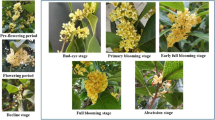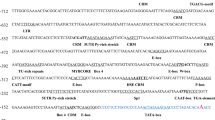Abstract
Oriental orchids of the genus Cymbidium are famous for their flower fragrance and have great value in the horticultural market. To investigate the regulatory mechanisms of fragrance biosynthesis in Cymbidium faberi, the promoters of the CfAOC and CfJMT genes in the methyl jasmonate biosynthesis pathway were cloned and analyzed. Notably, the CfAOC promoter was transcriptionally active in all vegetative organs, which was not true for the CfJMT promoter, indicating that the latter is tissue-specific for the flowers of C. faberi. The dual-luciferase assay showed that the fragment between –629 and –1038 nt of the CfAOC promoter, as well as the fragment between –960 and –1121 nt of the CfJMT promoter, displayed specific interaction with the CfbHLH transcription factors. These results provide a theoretical basis for the genetic modification of the flower fragrance of Cymbidium based on specific CfbHLH transcription factors.






Similar content being viewed by others
Availability of data and materials
Not applicable.
Code availability
Not applicable.
References
Ahmad B, Zhang S, Yao J, Rahman MU, Hanif M, Zhu Y, Wang X (2019) Genomic organization of the B3-domain transcription factor family in grapevine (Vitis vinifera L) and expression during seed development in seedless and seeded cultivars. Int J Mol Sci 20:4553
Chen L, Jiang B, Wu C, Sun S, Hou W, Han T (2014) GmPRP2 promoter drives root-preferential expression in transgenic Arabidopsis and soybean hairy roots. BMC Plant Biol 14:245
Choi H, Lyu JI, Lee HO, Kim JB, Kim SH (2020) Complete chloroplast genome sequence of an orchid hybrid Cymbidium sinense (♀) × C. goeringii (♂). Mitochondrial DNA B Resour 5:3784–3785
Eom JS, Luo D, Atienza-Grande G, Yang J, Ji C, Thi Luu V, Huguet-Tapia JC, Char SN, Liu B, Nguyen H, Schmidt SM, Szurek B, Vera Cruz C, White FF, Oliva R, Yang B, Frommer WB (2019) Diagnostic kit for rice blight resistance. Nat Biotechnol 37:1372–1379
Guan L, Denkert N, Eisa A, Lehmann M, Sjuts I, Weiberg A, Soll J, Meinecke M, Schwenkert S (2019) JASSY, a chloroplast outer membrane protein required for jasmonate biosynthesis. Proc Natl Acad Sci USA 116:10568–10575
Hernandez-Garcia CM, Finer JJ (2014) Identification and validation of promoters and cis-acting regulatory elements. Plant Sci 217–218:109–119
Hossain MM, Sharma M, Teixeira da Silva JA, Pathak P (2010) Seed germination and tissue culture of Cymbidium giganteum Wall. ex Lindl. Sci Hortic 123:479–487
Hossain MM, Kant R, Van PT, Winarto B, Zeng S, da Silva AT (2013) The application of biotechnology to Orchids. Crit Rev Plant Sci 32:69–139
Huang W, Khaldun ABM, Chen J, Zhang C, Lv H, Yuan L, Wang Y (2016) A R2R3-MYB transcription factor regulates the flavonol biosynthetic pathway in a traditional Chinese medicinal plant Epimedium sagittatum. Front Plant Sci 7:1089
Kaur A, Neelam K, Kitazumi A, Kaur K, Sharma P, Mangat GS, de los Reyes BG, Brar DS, Singh K, (2020) Novel cis-acting regulatory elements in wild Oryza species impart improved rice bran quality by lowering the expression of phospholipase D alpha1 enzyme (OsPLDα1). Mol Biol Rep 47:401–422
Ku YS, Sintaha M, Cheung MY, Lam HM (2018) Plant hormone signaling crosstalks between biotic and abiotic stress responses. Int J Mol Sci 19:3206
Lin X, Chen Y, Yi Y, Yan J, Zhang Z (2008) Promoter analysis of Bombyx mori nucleopolyhedrovirus ubiquitin gene. J Microbiol 46:429–435
Lorenzo O, Chico JM, Sánchez-Serrano JJ, Solano R (2004) JASMONATE-INSENSITIVE 1 encodes a MYC transcription factor essential to discriminate between different jasmonate-regulated defense responses in Arabidopsis. Plant Cell 16:1938–1950
Luan A, He Y, Xie T, Chen C, Mao Q, Wang X, Li C, Ding Y, Lin W, Liu C, Xia J, He J (2019) Identification of an embryonic cell-specific region within the pineapple SERK1 promoter. Genes 10:883
Lubliner S, Regev I, Lotan-Pompan M, Edelheit S, Weinberger A, Segal E (2015) Core promoter sequence in yeast is a major determinant of expression level. Genome Res 25:1008–1017
Na JK, Metzger JD (2014) Chimeric promoter mediates guard cell-specific gene expression in tobacco under water deficit. Biotechnol Lett 36:1893–1899
Nakata M, Mitsuda N, Herbe M, Koo AJK, Moreno JE, Suzuki K, Howe GA, Ohme-Takagi M (2013) A bHLH-type transcription factor, ABA-inducible BHLH-type transcription factor/JA-associated MYC2-LIKE1, acts as a repressor to negatively regulate jasmonate signaling in Arabidopsis. Plant Cell 25:1641–1656
Omata A, Nakamura S, Yomogida K, Moriai K, Ichikawa Y, Watanabe I (1990) Volatile components of TO-YO-RAN flowers (Cymbidium faberi and Cymbidium virescens). Agric Biol Chem 54:1029–1033
Qi T, Huang H, Wu D, Yan J, Qi Y, Song S, Xie D (2014) Arabidopsis DELLA and JAZ proteins bind the WD-repeat/bHLH/MYB complex to modulate gibberellin and jasmonate signaling synergy. Plant Cell 26:1118–1133
Ramya M, Park PH, Chuang YC, Kwon OK, An HR, Park PM, Baek YS, Kang BC, Tsai WC, Chen HH (2019) RNA sequencing analysis of Cymbidium goeringii identifies floral scent biosynthesis related genes. BMC Plant Biol 19:337
Ren Q, Zhong Z, Wang Y, You Q, Li Q, Yuan M, He Y, Qi C, Tang X, Zheng X, Zhang T, Qi Y, Zhang Y (2019) Bidirectional promoter-based CRISPR-Cas9 systems for plant genome editing. Front Plant Sci 10:1173
Riemann M, Haga K, Shimizu T, Okada K, Ando S, Mochizuki S, Nishizawa Y, Yamanouchi U, Nick P, Yano M, Minami E, Takano M, Yamane H, Lino M (2013) Identification of rice Allene Oxide Cyclase mutants and the function of jasmonate for defence against Magnaporthe oryzae. Plant J 74:226–238
Seo HS, Song JT, Cheong JJ, Lee YH, Lee YW, Hwang I, Lee JS, Choi YD (2001) Jasmonic acid carboxyl methyltransferase: a key enzyme for jasmonate-regulated plant responses. Proc Natl Acad Sci USA 98(8):4788–4793
Shin S, Lv J, Fazio G, Mazzola M, Zhu Y (2014) Transcriptional regulation of ethylene and jasmonate mediated defense respons e in apple (Malus domestica) root during Pythium ultimum infection. Hortic Res 1:14053
Song S, Huang H, Gao H, Wang J, Wu D, Liu X, Yang S, Zhai Q, Li C, Qi T, Xie D (2014) Interaction between MYC2 and ethylene insensitive3 modulates antagonism between jasmonate and ethylene signaling in Arabidopsis. Plant Cell 26:263–279
Tzean Y, Chang H, Tu T, Hou B, Chen H, Chiu Y, Chou W, Chang L, Yeh H (2020) Engineering plant resistance to Tomato yellow leaf curl Thailand virus using phloem-specific promoter expressing hairpin RNA. Mol Plant Microbe Interact 33:87–97
Wang H, Tong C, Jang S (2017) Current progress in orchid flowering/flower development research. Plant Signal Behav 12:e1322245
Wang SL, Viswanath KK, Tong CG, An HR, Jang S, Chen FC (2019) Floral induction and flower development of orchids. Front Plant Sci 10:1258
Wei Y, Jin J, Yao X, Lu C, Zhu G, Yang F (2020) Transcriptome analysis reveals clues into leaf-like flower mutant in Chinese orchid Cymbidium ensifolium. Plant Divers 42:92–101
Winterhagen P, Hagemann MH, Wünsche JN (2019) Different regulatory modules of two mango ERS1promoters modulate specific gene expression in response to phytohormones in transgenic model plants. Plant Sci 289:110269
Xu Q, Wang S, Hong H, Zhou Y (2019) Transcriptomic profiling of the flower scent biosynthesis pathway of Cymbidium faberi Rolfe and functional characterization of its jasmonic acid carboxyl methyltransferase gene. BMC Genomics 20:125
Xu Y, Zhou J, Lu S, Wang S, Zhou Y (2020a) Cloning and molecular characterization of CfMYBs associated with the regulation of methyl jasmonate biosynthesis in Cymbidium faberi. Hortic J 89:593–601
Xu Y, Zhou J, Liu Q, Li K, Zhou Y (2020b) Construction and characterization of a high-quality cDNA library of Cymbidium faberi suitable for yeast one- and two-hybrid assays. BMC Biotechnol 20:4
Yang J, Duan GH, Li CQ, Liu L, Han GY, Zhang YL, Wang CM (2019) The crosstalks between jasmonic acid and other plant hormone signaling highlight the involvement of jasmonic acid as a core component in plant response to biotic and abiotic stresses. Front Plant Sci 10:1349
Zhang X, Zhu Z, An F, Hao D, Li P, Song J, Yi C, Guo H (2014) Jasmonate-activated MYC2 represses ethylene insensitive3 activity to antagonize ethylene-promoted apical hook formation in Arabidopsis. Plant Cell 26:1105–1117
Zhang S, Yang Y, Li J, Qin J, Zhang W, Huang W, Hu H (2018) Physiological diversity of orchids. Plant Divers 40:196–208
Zhang X, He Y, He W, Su H, Wang Y, Hong G, Xu P (2019) Structural and functional insights into the LBD family involved in abiotic stress and flavonoid synthases in Camellia sinensis. Sci Rep 9:15651
Zhao ML, Wang JN, Shan W, Fan JG, Kuang JF, Wu KQ, Li XP, Chen WX, He FY, Chen JY, Lu WJ (2013) Induction of jasmonate signalling regulators MaMYC2s and their physical interactions with MaICE1 in methyl jasmonate-induced chilling tolerance in banana fruit. Plant Cell Environ 36:30–51
Zhou Y, Yau Y, Ow DW, Wang Y (2012) Site-specific deletions in the tomato genome by the CinH-RS2 and ParA-MRS recombination systems. Plant Biotechnol Rep 6(3):225–232
Zhou Y, Chen L, Xu Y, Wang Y, Wang S, Ge X (2018) The CfAOS and CfAOC genes related to flower fragrance biosynthesis in Cymbidium faberi could confer drought tolerance to transgenic tomatoes. Int J Agric Biol 20:883–892
Zhuo M, Sakuraba Y, Yanagisawa S (2020) A jasmonate-activated MYC2-Dof2.1-MYC2 transcriptional loop promotes leaf senescence in Arabidopsis. Plant Cell 32:242–262
Zimmermann IM, Heim MA, Weisshaar B, Uhrig JF (2004) Comprehensive identification of Arabidopsis thaliana MYB transcription factors interacting with R/B-like BHLH proteins. Plant J 40:22–34
Acknowledgements
This work was supported by the National Natural Science Foundation of China (Grant No. 31700626 and 82060684), Science and Technology Research Project, Education Department of Hubei province (No. B2021290), 1050 Young Talents Project of Jiangxi University of Traditional Chinese Medicine (5141900107) and the Scientific Research Foundation for the First-class Discipline of Chinese Medicine Program of Jiangxi University of Traditional Chinese Medicine (JXSYLXK-ZHYAO023). These funding bodies did not play any role in the design, execution, analysis, and interpretations of data or in writing the manuscript.
Funding
National Natural Science Foundation of China, 31700626, Yin Zhou,82060684, Yanqin Xu, Science and Technology Research Project, Education Department of Hubei province, B2021290, Yin Zhou, 1050 Young Talents Project of Jiangxi University of Traditional Chinese Medicine, 5141900107, Yanqin Xu, Scientific Research Foundation for the First-class Discipline of Chinese Medicine Program of Jiangxi University of Traditional Chinese Medicine, JXSYLXK-ZHYAO023, Yanqin Xu
Author information
Authors and Affiliations
Contributions
Conceived and designed the experiments: YZ and YX. Performed the experiments: ZX, XC, JZ and SW. Analyzed the data: YZ, YX, and ZX. Wrote the paper: YZ. All the authors have read the manuscript and approved for publication.
Corresponding author
Ethics declarations
Conflict of interest
The authors declare that they have no conflict of interest.
Ethical approval
The article does not contain any studies with human participants or animals performed by any of the authors.
Consent to publication.
All authors in the manuscript declare a consensus with publishing in Plant Biotechnology Reports.
Additional information
Publisher's Note
Springer Nature remains neutral with regard to jurisdictional claims in published maps and institutional affiliations.
Supplementary Information
Below is the link to the electronic supplementary material.
Rights and permissions
About this article
Cite this article
Zhou, Y., Xu, Z., Chen, X. et al. Functional characterization of the CfAOC and CfJMT gene promoters related to MeJA biosynthesis in Cymbidium faberi. Plant Biotechnol Rep 17, 243–253 (2023). https://doi.org/10.1007/s11816-022-00780-y
Received:
Revised:
Accepted:
Published:
Issue Date:
DOI: https://doi.org/10.1007/s11816-022-00780-y




